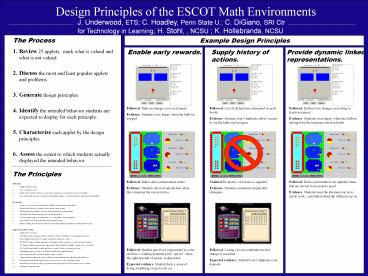Design Principles of the ESCOT Math Environments - PowerPoint PPT Presentation
Title:
Design Principles of the ESCOT Math Environments
Description:
Title: PowerPoint Presentation Author: Administrator Last modified by: Alexis Whaley Created Date: 2/26/2003 10:27:19 PM Document presentation format – PowerPoint PPT presentation
Number of Views:16
Avg rating:3.0/5.0
Title: Design Principles of the ESCOT Math Environments
1
Design Principles of the ESCOT Math Environments
J. Underwood, ETS C. Hoadley, Penn State U. C.
DiGiano, SRI Ctr for Technology in Learning H.
Stohl, , NCSU K. Hollebrands, NCSU
The Process
Example Design Principles
- Review 25 applets, mark what is valued and what
is not valued. - Discuss the most and least popular applets and
problems. - Generate design principles.
- Identify the intended behavior students are
expected to display for each principle. - Characterize each applet by the design
principles. - Assess the extent to which students actually
displayed the intended behavior.
Enable early rewards.
Provide dynamic linked representations.
Supply history of actions.
Followed Balloon changes size on
demand. Evidence Students were happy when the
balloon popped.
Followed Balloon size changes according to
fraction entered. Evidence Students were happy
when the balloon enlarged for the improper
fraction booth.
Followed List of all fractions attempted in each
booth. Evidence Students dont duplicate effort,
except to see the balloon pop again.
The Principles
ViolatedNo history of actions is
supplied. Evidence Students sometimes duplicated
strategies.
Followed Ratios show intermediate
states. Evidence Students showed satisfaction
when they maintain the correct ratios.
Followed Ratios and numbers are updated when
fish are moved from pond to pond. Evidence
Students used the alternate repns to check work
and talked about the different repns.
- Motivation
- Familiar problem context
- Use second person voice
- Enable early reward for students (e.g. provide
easy questions or activities they can do
successfully) - For videogame-like activities, interactivity,
high-quality graphics, etc. should match user
expectations for playability - Presentation
- Question, cover story and/or introduction should
be clear, unwordy, unsuperfluous - Proofread text, labels, etc, with target users
and age range in mind - All other things being equal, use professional
conventions for content domain - Make links between representations obvious and
ungratuitous - Use high-quality graphics and other media (e.g.,
still graphics, audio, animation) - Draw attention only to things that support the
problem solving - Make everything described in the question obvious
in the applet align interactive and
noninteractive parts - Support for problem-solving
- Supply history of actions
- Everything in there (questions, interface
elements, activities) should have a sound
pedagogical reason - Allow multiple entry points (e.g., ability,
experiences, preferences, styles...)
Followed Student gets food, represented as a
list, just like a vending machine gives prizes
when the right amount of money is
deposited. Expected evidence Student feels a
sense of doing something correct early on.
Followed Listing of coin combinations and change
is recorded. Expected evidence Student wont
duplicate coin deposits.































